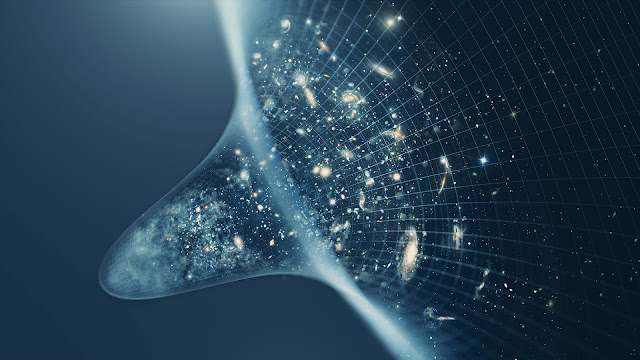The universe may have existed forever, according to a new model that applies quantum correction terms to complement Einstein’s theory of general relativity. The model can also account for dark matter and energy, solving multiple problems at once.
The widely accepted age of the universe, as estimated by general relativity, is 13.8 billion years. At first, everything that existed was thought to occupy a single, infinitely dense point, or singularity. Only after this point began to expand in a “Big Bang” did the universe officially begin.
Although the Big Bang singularity arises directly and inevitably from the mathematics of general relativity, some scientists view it as problematic because the mathematics can only explain what happened immediately after the singularity (not before or at it).
“The Big Bang singularity is the most serious problem in general relativity because the laws of physics seem to break down there,” Ahmed Farag Ali of Benha University and Zewail Science and Technology City, both in Egypt, told Phys.org.
Ali and co-author Saurya Das of the University of Lethbridge in Alberta, Canada, have shown in a paper published in Physics Letters B that the Big Bang singularity can be resolved using their new model in which the universe has no beginning or end.
The physicists emphasize that their quantum correction terms are not applied ad hoc in an attempt to specifically eliminate the Big Bang singularity. Their work is based on ideas by theoretical physicist David Bohm, who is also known for his contributions to the philosophy of physics. Beginning in the 1950s, Bohm explored replacing classical geodesics (the shortest path between two points on a curved surface) with quantum trajectories.
In their paper, Ali and Das applied these Bohmian trajectories to an equation developed in the 1950s by physicist Amal Kumar Raychaudhuri at Presidency University in Calcutta, India. Raychaudhuri was also Das’s teacher when he was a student at that institution in the 1990s.
Using the quantum-corrected Raychaudhuri equation, Ali and Das derived quantum-corrected Friedmann equations, which describe the expansion and evolution of the universe (including the Big Bang) within the context of general relativity. Although not a true theory of quantum gravity, the model contains elements of both quantum theory and general relativity. Ali and Das also expect their results to hold even when a full theory of quantum gravity is formulated.
No singularities or dark things
In addition to not predicting a Big Bang singularity, the new model also does not predict a “big crunch” singularity. In general relativity, one possible fate of the universe is for it to begin shrinking until it collapses in on itself in a big crunch and becomes an infinitely dense point again.
Ali and Das explain in their paper that their model avoids singularities because of a key difference between classical geodesics and Bohmian trajectories. Classical geodesics eventually intersect each other, and the points at which they converge are singularities. In contrast, Bohmian trajectories never intersect, so singularities do not appear in the equations.
In cosmological terms, scientists explain that quantum corrections can be thought of as a cosmological constant term (no dark energy required) and a radiation term. These terms keep the universe at a finite size and therefore give it an infinite age. The terms also make predictions that agree closely with current observations of the cosmological constant and the density of the universe.
New gravity particle
In physical terms, the model describes the universe as if it were filled with a quantum fluid. Scientists propose that this fluid could be composed of gravitons, hypothetical massless particles that mediate the force of gravity. If they exist, gravitons are thought to play a key role in a theory of quantum gravity.
In a related paper, Das and another collaborator, Rajat Bhaduri of McMaster University, Canada, have given further credence to this model. They show that gravitons can form a Bose-Einstein condensate (named after Einstein and another Indian physicist, Satyendranath Bose) at temperatures that have been present in the universe at all times.
Motivated by the model’s potential to resolve the Big Bang singularity and explain dark matter and energy, the physicists plan to analyze their model more rigorously in the future. Their future work includes redoing their study by taking into account small inhomogeneous and anisotropic perturbations, but they do not expect the small perturbations to significantly affect the results.
“It’s satisfying to see that such simple fixes can potentially solve so many problems at once,” Das said.



